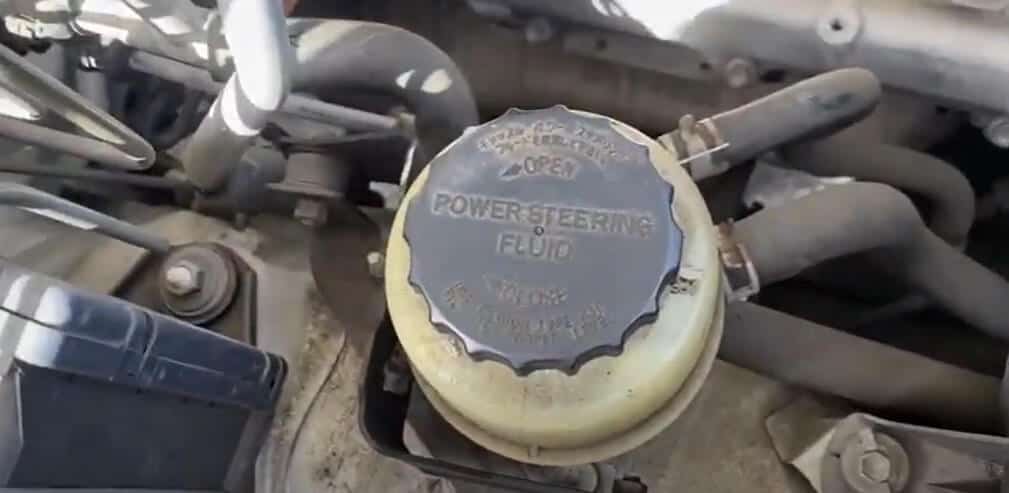A hard-to-turn steering wheel usually leads to one of two things. You’ll have arms like pop-eye if you continue driving, or you’ll get so fed up you will have no choice but to fix the issue.
To be clear, we aren’t saying it is safe to drive because without knowing the fault, that’s difficult. If your steering wheel is hard to turn, it usually means the power steering is not working. This article includes more details and six other commonly found problems. Once you check each of these out, you will find one is the cause of your problems.
7 Possible Reasons Why It’s Hard to Turn Your Steering Wheel
The below seven reasons are the most common issues I have come across over the years when inspecting a vehicle with stiff steering.
Flat tire
For obvious reasons, the steering becomes heavy if the tire is flat. It doesn’t need to be a flat tire; being low on pressure can be enough to cause the steering to stiffen. Fixing the tire pressure is extremely easy and is the first thing you should check if you find your steering hard to turn.
If you find the tire pressure extremely low, monitoring the pressure over a few hours/days is wise to check it doesn’t drop again. If it does, you guessed it; you may have a puncture that needs investigation.
Broken suspension component
Suspension problems, such as a broken coil spring or collapsed front suspension strut, will make turning the wheel difficult or impossible. Any issues with the suspension usually accompany knocking, rattling, or clunking noises when going over bumps.
A broken coil spring is particularly dangerous because if the coil is no longer in the pan, it can cause a tire blowout. It’s also known that the spring can catch and jam into other parts of the suspension, stopping you from turning the wheel, or even more dangerously, it can snatch the car off in different directions when driving.
Broken suspension repairs should only be done with the correct tools, especially on the front. Bushes need may pressing into arms, and the coil springs need compressing to mount onto a shock absorber strut. They are hazardous items to compress that cause broken bones when they go wrong. Only trained mechanics with the correct tools should replace these items. However, you can sometimes buy the whole strut leg with a new spring attached, which is relatively easy to switch out with the old.
Power steering pump failure
Usually, power steering pumps fail because of fluid leaks, but this may not be the case if the fluid level is still correct; the pump’s internals can fail. There are other indications to look for that suggest the pump has failed:
- Metal filings in the power steering fluid
- Power steering pump noise. The pump should be quiet when turning the wheel without strange screeching noises.
- Power steering working intermittently
- Power steering warning light on the dashboard
Replacing a power steering pump is relatively easy but can be laborious. The steering pump is sometimes mounted behind the back of the engine, which means lots of engine auxiliaries need to be removed to change the pump. I do not recommend undertaking this type of repair without knowing what you are removing or how it works.
Worn steering rack
Modern vehicles have rack and pinion steering racks, which consist of a rack and pinion gear. The gear moves along the rack as you input the steering, pushing the wheels in a particular direction. The pinion gear and teeth on the rack can wear out over time, which can cause the steering to loosen and then tighten.
However, as mentioned, most problems with the steering racks are caused by fluid leakage. Even though the fluid level may be correct, it would be wise to check there is no debris in the liquid; contaminated fluid will aid in speeding up the wear on the rack.
Replacing a steering rack is no 5-minute job and requires much work. Steering racks are expensive, so if you need replacing without proper knowledge, it’s best left to a trained mechanic.
Broken serpentine belt
The serpentine belt has many names: V-belt, auxiliary, and power steering belt; it is a secondary belt that usually connects the alternator and bottom pulley to the power steering pump. Without this belt, the power steering pump will not work. The serpentine belt is distinct from the drive belt (cam belt), and the two should not be confused.
There are signs that the belt has broken without the need to look in the engine bay. The battery charging/ warning light for one; with this illuminated, the alternator is not charging, which is another good indicator alongside the steering wheel being difficult to turn, especially at low speeds.
Replacing the belt is straightforward and can be done at home with a basic tool set. Vehicles have a variation of a tensioner pulley, which you will need to slacken off to fit the belt and then readjust to ensure it is tensioned afterward. You need to know the correct orientation of the belt to refit a new one; a diagram can be acquired with a quick search online. If unsure, most mechanics would fit a new one in less than an hour.
Incorrect wheel alignment angles
As you may already know, the wheel alignment or toe angle affects the car pulling off to one side or pointing straight. However, problems with the camber or caster angles make a huge difference to the input on the steering wheel.
Severe problems with camber and caster will be very obvious to the eye. The top should be slightly angled inwards when looking down at the wheel from the top of the fender. Both should look at equal angles. The only way to be sure is to inspect the car’s 4-wheel alignment. It cannot be done at home on the driveway without the correct gauges to check each wheel’s angle.
Some old-time mechanics might be reading this and saying we can do it with string and a ruler. Still, the modern multilink suspension is almost only possible to get right without a four-wheel alignment machine telling you the readings of all angles simultaneously. Most tire replacement garages now have 4-wheel alignment machines to check and adjust every angle. It is usually a quick service that costs between 50 and a couple hundred dollars, depending on the required adjustments.
Thick power steering fluid
Just because the power steering fluid level is correct does not mean it is in good condition. Like all hydraulic fluids, they have a life span and need replacing occasionally. When the power steering fluid is old, the consistency of the fluid changes, and it becomes thick. The thick fluid does not lubricate inside the steering rack or power steering motor effectively, meaning friction and grinding between the gears.
Replacing the power steering fluid is pretty straightforward; some power steering pumps have a drain plug, while others don’t. If they don’t, you must remove the lowest hose in the power steering pump and let the fluid drain. Be sure to catch the fluid in a container, as it needs to be disposed of correctly. After refitting the hose and filling the power steering fluid, the air caught in the system must be bled off. To do a bleed on the power steering pump, have the vehicle idling, remove the power steering fluid cap, then turn the steering wheel from lock to lock a few times, and you will hear a few glugs of air pushed out of the fluid. Once the noises of air release disappear, you can be confident you have successfully bled the power steering system.

How Do You Diagnose What’s Causing Difficult to Turn Steering?
Below is how I check what is causing a difficult to turn steering wheel.
- Check the power steering fluid level is correct (read point 6 below if the level is very low)
- Make sure the serpentine belt is still there and complete.
- Check the tire pressures.
- Check all suspension components are intact and not broken.
- When turning the steering with the car idling, listen for the buzzing noise, confirming the power steering pump is operating.
- If topping up the power steering fluid, it may need bleeding. With the fluid cap off, turn the steering wheel from one full lock to another and repeat a few times.
If you find an issue with any of the above, you likely now know the cause. However, if none of the above helps diagnose a stiff steering issue, it would be best to take your car to the garage for inspection.
Can You Drive With a Difficult to Turn Steering Wheel?
You should avoid driving with a steering wheel that is difficult to turn until you know what is causing the fault. You may end up driving the car with a hazardous fault that could harm you or other road users. Once you’ve diagnosed the fault, it may be possible to go; however, when the steering is stiff, it will be a power steering issue to blame, making driving very tricky.
Can you drive a car without the power steering working?
Classic cars and older vehicles didn’t have power steering; it is relatively new. Driving without power steering was never an issue to those who never had it, so it is relatively easy.
Maneuvering a vehicle at low speeds without power steering takes much more effort. The steering becomes much more manageable as soon as the car is in motion.
This is a similar scenario; if the power steering were to fail, it would still be possible to drive the car. However, parking and local low-speed driving will now be difficult.
Frequently Asked Questions
What Is The Most Common Cause Of Heavy Steering?
The most common cause for heavy steering is power steering failure. With the power steering inoperable you will find it difficult to turn the steering wheel, especially when stationary or at low speeds.
Can A Low Battery Cause Power Steering Problems?
A weak battery can effect the power steering if the vehicle is fitted with an electric power steering system.
Does Power Steering Fail Suddenly?
Depending on the fault with the power steering system failure is usually gradual, you may notice small squeaks or noises when turning the steering wheel. However, they can also fail suddenly when driving along without any warning.
Conclusion
Hopefully, one of the seven items in this article is the cause of your hard-to-turn steering wheel. Repairing some of these items can be extremely simple, and you should take your time. Run through the list and check the things you can check before booking the car into the garage; you might be surprised to find the cause of the problem yourself and save some money on a repair bill.
If you find an issue with any of the above, you likely now know the cause. However, if none of the above helps diagnose a stiff steering issue, it would be best to take your car to the garage for inspection.









